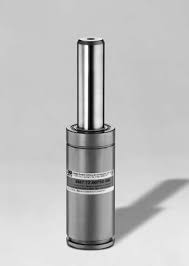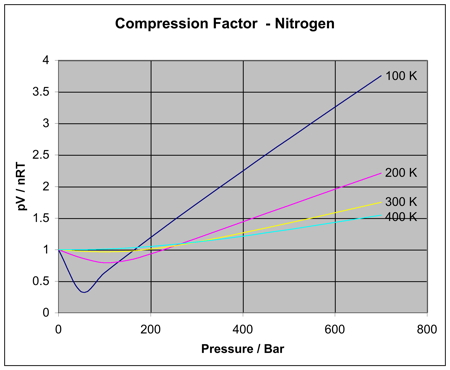Hi all,
I have a quetion about the compression of a gas spring like the one in the picture
 .
.
We see that there are energy-losses (hysteresis) if we deflect the gas spring. So, for example, if we load the gas spring, this costs us 100J, but in unloading the gas spring 'only' returhs 80J. So the question is: where did the 20J go?
We initially thought that this energy is lost in fiction between the cylinder and the seal. However, the manufacturer suggested that this energy may be lost in heat generation due to the compression of the gas (nitrogen) inside the gas spring. I want to check this mathematically, but I am not sure whether I do this correctly.
Assume that we have a starting situation, in which:
Volume = V0 = 0.006 L
Pressure = P0 = 180 bar
Temperature = T0 = 293 K
Then we defect/compress the gas spring, to a situation in wich:
Volume = V1 = 0.0036 L
Pressure = P1 = ?
Temperature = T1 = ?
Now I want to know the amount of energy in Joules that is 'lost' in this compression.
What I did is:
Calculate P1 using P1=P0*(V0/V1)^gamma, in which gamma=cp/cv=1.4 --> P1 = 368 bar
Calculate T1 using T1=(P1*V1)/(P0*V0)*T0 --> T1 = 359 K
Calculate the amount of nitrogen gas inside the gas spring (in moles) using n=(P*V)/(R*T) --> n = 0.044 mol
Calculate the mass of the nitrogen gas inside the gas spring (in kg) using m=M*n --> m = 0.616*10^-3 kg
Calculate the energy that is 'lost' in heating the nitrogen during compression using Q=c*m*(T1-T0) --> Q = 42J
Is my calculation correct? How should I interpretate this result?
Deflecting/compressing the gas spring to its full stroke costs 60J. Does this mean that 42J out of this 60J is 'used' to heat the nitrogen during compression?
And is this energy 'lost', as in, does the gas spring return this energy in unloading?
Thank you in advance!
Bas
I have a quetion about the compression of a gas spring like the one in the picture

We see that there are energy-losses (hysteresis) if we deflect the gas spring. So, for example, if we load the gas spring, this costs us 100J, but in unloading the gas spring 'only' returhs 80J. So the question is: where did the 20J go?
We initially thought that this energy is lost in fiction between the cylinder and the seal. However, the manufacturer suggested that this energy may be lost in heat generation due to the compression of the gas (nitrogen) inside the gas spring. I want to check this mathematically, but I am not sure whether I do this correctly.
Assume that we have a starting situation, in which:
Volume = V0 = 0.006 L
Pressure = P0 = 180 bar
Temperature = T0 = 293 K
Then we defect/compress the gas spring, to a situation in wich:
Volume = V1 = 0.0036 L
Pressure = P1 = ?
Temperature = T1 = ?
Now I want to know the amount of energy in Joules that is 'lost' in this compression.
What I did is:
Calculate P1 using P1=P0*(V0/V1)^gamma, in which gamma=cp/cv=1.4 --> P1 = 368 bar
Calculate T1 using T1=(P1*V1)/(P0*V0)*T0 --> T1 = 359 K
Calculate the amount of nitrogen gas inside the gas spring (in moles) using n=(P*V)/(R*T) --> n = 0.044 mol
Calculate the mass of the nitrogen gas inside the gas spring (in kg) using m=M*n --> m = 0.616*10^-3 kg
Calculate the energy that is 'lost' in heating the nitrogen during compression using Q=c*m*(T1-T0) --> Q = 42J
Is my calculation correct? How should I interpretate this result?
Deflecting/compressing the gas spring to its full stroke costs 60J. Does this mean that 42J out of this 60J is 'used' to heat the nitrogen during compression?
And is this energy 'lost', as in, does the gas spring return this energy in unloading?
Thank you in advance!
Bas


![[smile] [smile] [smile]](/data/assets/smilies/smile.gif)